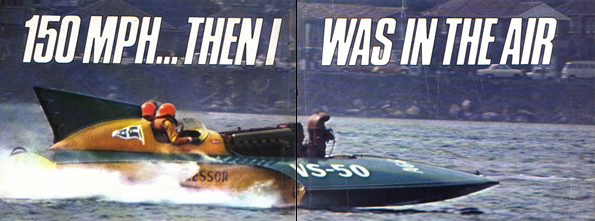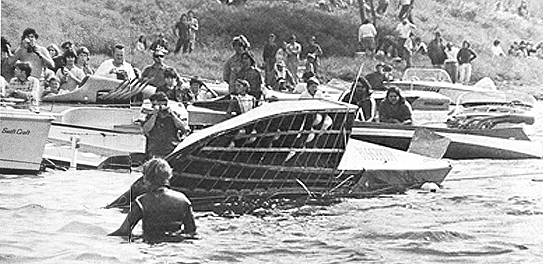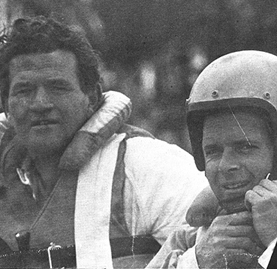The
2000 horsepower, 27-foot giant hydroplane partially disintegrated.
What was it like? How did it happen? Now turn over for the driver’s
story… by Dave Tenny, as told to Graeme Andrews….

I REMEMBER THINKING this is it. I’m going to die. I was10 to 15 feet up in the air. . . the boat was falling away behind me. I don’t remember flying through the air. I don’t remember landing or coming to the surface.
When I realized that I was afloat and alive, I was amazed. And I’m still amazed. I shake every time I think of it.
My helmet was torn off. My shoes and socks were gone. Then I remember thinking, ‘I’d better see if I can move. First a leg, then an arm. Then the other arm and the leg. They all worked... just.


I felt as if I could get up and walk around. But I began to feel it a bit later on. In hospital, I was in so much pain from chipped bones and torn muscles that I couldn’t lie still. And it hurt to move.
By this time my real worry was Les. I knew that he had survived. But I didn’t know then how badly injured he was.
They told me later that Les was clinically dead when they got him ashore.
We were pretty lucky that a doctor was on the spot to look after him.
How did it all happen? I’m still trying to work that out. When
you’re going around 150 miles an hour in a four ton boat like the
Aggressor, things can happen pretty quickly. I was really pushing it.
Air New Zealand had already beaten us once and I was determined it wasn’t
going to happen again.
It was in lap two. . . or was it the beginning of lap three? Anyway, we were running down the straight about 200 feet behind Air New Zealand. Then the sponson began to dig in and we swerved to the left.
Then I’m up in the air.
But I’m not giving up. There’s too much of me in that boat. I’m determined to have another go at Air New Zealand and beat her unlimited Australasian record of 157 miles an hour. I reckon Aggressor can do 180 miles an hour. . . with the proper work I could get her to 200.
Then I want to have a go at the British Commonwealth record and finally the world record.
I wouldn’t mind having a go at the Harmsworth Cup, the top competitive power boat race in the world. The United States hold it — they’ve won it 16 times — and we’ve never competed for it. I’d like to bring that cup home.
But a lot of it is up to my wife, June. She’s not too keen on me going on at the moment, but she always comes around. She’s really worked for that boat, too. I’ve never earned more than 80 bucks a week in my life. She has scrubbed schools at night and really gone without. She wanted to have a baby, too, but we put that off for years. Now we have a son Noel… just 12 months old. I suppose I have to think about him too...
When she wasn’t working, she was at home helping to manhandle the engine. And when that wasn’t keeping her occupied, she sewed the Record racing life jackets. She reckons she made the one that saved me.
I’ve spent about $12,000 on the boat over 10 years. And I’ve got very little back in prize money ... there just isn’t any. In a major race, I might win $200 for first — if I’m lucky. Mostly, I just race for trophies. . . I’ve got a pretty fair collection this season, including the Griffith Cup (the top Australian trophy and the oldest).
I use about 15 gallons of 100 octane fuel every time I do a 10-lap race. The tank holds 30 gallons and the sump takes eight gallons of oil.
We carry two complete sets of spark plugs with us; we’d like to have more, but she takes 24 in her 12 cylinders and that’s about as much as we can afford.(Continued on page 64) (Page 64 not available)

What Aggressor looked like when towed ashore.

Les Scott (left) who was badly injured in the crash, with Dave just before the start of the race.
Dave Tenny and his wife, June, examine a piece of Aggressor.
By Dave Tenny, as told to Graeme Andrews - MAN magazine
HOME